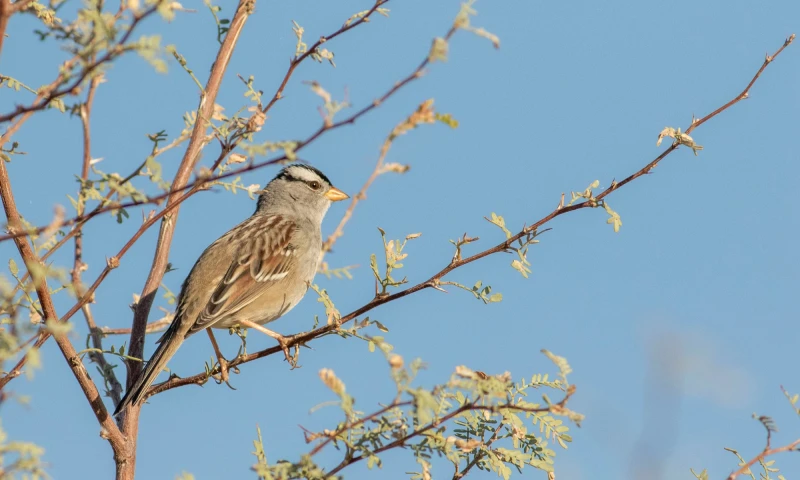By Alex Harper
October is a month of intense change for bird diversity in southern Nevada. The experience that one might have at the very beginning of the month is likely going to be very different from the end if out observing birds. Throughout the month, transiting birds arrive with gradually intensifying cold fronts coming from the north. These colder temperatures begin to suppress insect activity, forcing most insect-eating birds to move to lower latitudes where food is more consistent. Many of our vireos, thrushes, flycatchers, warblers and tanagers will spend their winters anywhere from Mexico to South America. In these locations, they are as equally at home as they are in North America, and there are enough insects and fruit-bearing trees to accommodate the diversity of residential birds and the snowbirds.
Like passing waves, each front helps to propel birds to the north into southern Nevada, while moving other birds out to more southerly areas. The assemblage – the totality of birds represented at one location during a snapshot in time – also take on an identity that marks a later stage of landbird migration. These are the more cold-tolerant species of birds that can find food and survive under colder conditions, and many of them mark the signs and sounds of winter. Sapsuckers, flickers, Ruby-crowned Kinglets, Yellow-rumped Warblers and White-crowned Sparrows are some of these, and they will become more noticeable throughout southern Nevada’s popular birding sites. Look through groups of American Robins or Brewer’s Blackbirds begin to appear more and more in all the places we’d expect to see a Great-tailed Grackle.
Some are passing through to areas farther south, while many others will establish wintering territories in parks and neighborhoods. There is still very little known about how birds establish themselves individually over the landscape in these ways, but this is happening for all of October in southern Nevada.
Sparrow diversity changes drastically during this phase of migration. Chipping and Brewer’s continue to move out towards grassier areas such as Avi Kwa Ame, the Sonoran Desert and Mexico. Savannah Sparrows move into weedy areas and even ballfields in suburban parks. Lincoln’s quietly take over stands of invasive Phragmites or wetland edges. Dark-eyed Juncos prefer grassy parks with groves of trees. Look through amassing groups of boisterous White-crowned Sparrows for Golden-crowned and White-throated Sparrows. Many sparrows will take advantage of the bounty of seeds that were produced during the closing growing season.
At wetlands, transient shorebirds have mostly moved in and out, and waterfowl begin to move in. Southern Nevada hosts about twenty-five species of geese and ducks. Many of them will be arriving from wetlands in the Great Plains, Great Basin, or beyond. Visit the bird preserve or Las Vegas Wash in the morning and watch the numbers of waterfowl moving in and out of the region to appreciate the volume of ducks that move through the Las Vegas Valley.
October is a great month for wildcard birding. During October, more irruptive species may be absent or present. Irruptive species are species of birds whose movements are dictated by resources that are less influenced by altitude and are more influenced by other factors. In the Western United States, Red-breasted Nuthatches and most finches tend to be the most irruptive, since their food sources are usually cone-bearing trees. Birds gravitate towards crops of successful trees and avoid areas with less success. This can be problematic if more trees in more regions begin to fail. Witnessing Red Crossbills, Evening Grosbeaks and other montane finches in the Las Vegas is possible in October. Finches are often moving between mountain ranges looking for good pine, fir or spruce crop and drop into lowland parks to drink water.
Other wildcards could be wayward eastern songbirds that are out of the range that we expect them in. Warblers are especially prone to showing up, and the classic areas to look for uncommon species are areas that have tall trees, some groundcover (the more, the better) and water. Some popular places to search for many migratory land birds include Corn Creek Field Station, Floyd Lamb Park, the Henderson Bird Viewing Preserve, Clark County Wetlands Park, and Craig Ranch Regional Park. The more you get out with the intention of noticing more, the more chances there are to notice the birds that stand out as different.
Get out on the days following cold fronts and observe the changes since the last one. There are insights to glean from those experiences, and they are all useful in your own endeavor to understand the movements of birds around you.










